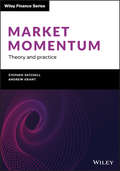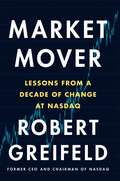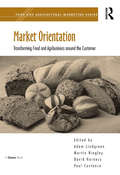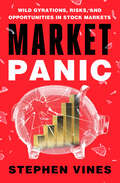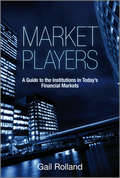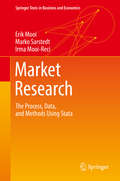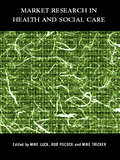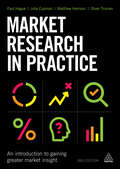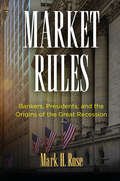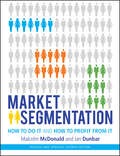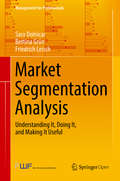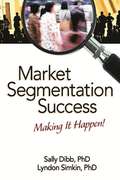- Table View
- List View
Market Momentum: Theory and Practice (The Wiley Finance Series)
by Andrew Grant Stephen SatchellA one-of-a-kind reference guide covering the behavioral and statistical explanations for market momentum and the implementation of momentum trading strategies Market Momentum: Theory and Practice is a thorough, how-to reference guide for a full range of financial professionals and students. It examines the behavioral and statistical causes of market momentum while also exploring the practical side of implementing related strategies. The phenomenon of momentum in finance occurs when past high returns are followed by subsequent high returns, and past low returns are followed by subsequent low returns. Market Momentum provides a detailed introduction to the financial topic, while examining existing literature. Recent academic and practitioner research is included, offering a more up-to-date perspective. What type of book is Market Momentum and how does it serve a range of readers’ interests and needs? A holistic market momentum guide for industry professionals, asset managers, risk managers, firm managers, plus hedge fund and commodity trading advisors Advanced text to help graduate students in finance, economics, and mathematics further develop their funds management skills Useful resource for financial practitioners who want to implement momentum trading strategies Reference book providing behavioral and statistical explanations for market momentum Due to claims that the phenomenon of momentum goes against the Efficient Markets Hypothesis, behavioral economists have studied the topic in-depth. However, many books published on the subject are written to provide advice on how to make money. In contrast, Market Momentum offers a comprehensive approach to the topic, which makes it a valuable resource for both investment professionals and higher-level finance students. The contributors address momentum theory and practice, while also offering trading strategies that practitioners can study.
Market Mover: Lessons from a Decade of Change at Nasdaq
by Robert GreifeldFormer CEO and Chairman of Nasdaq, Robert Greifeld shares stories, insights, and lessons learned from one of the world's largest stock exchanges, detailing his transformation of Nasdaq from a fledgling U.S. equities market to a global financial technology company. During 2003, the U.S. economy was described by one economist as "nervous, anxious, and waiting." In December the Dow had topped 10,000 for the first time in a year and a half, and at year's end the markets were up for the first time since 1999. But in the same year, American troops had moved into Iraq, and corporate boards were cutting CEOs at the slightest signs of trouble.Amidst this turmoil Robert Greifeld, a former tech entrepreneur from outside the Wall Street bubble, became CEO of Nasdaq, a position he would hold for the next thirteen years. He saw the company through one of the most mercurial economic periods in history: the Bernie Madoff mega-scandal; Facebook's tumultuous and disastrous IPO; Hurricane Sandy's disruption of the world's financial hub; the implosion of America's housing market and the global economic crash that followed, from which we have yet to fully recover. In Market Mover, Bob will write a first-hand account of the most critical moments of his career, with each chapter focusing on a headline-making event and ending with a prescriptive takeaway to impart to his readers. Now Bob, who stepped aside as Nasdaq's CEO at the end of 2016, is eager to look back at more than a decade of transformational change that occurred on his watch in order to share his insights and lessons with business readers.
Market Mover: Lessons from a Decade of Change at Nasdaq
by Robert GreifeldRobert Greifeld was CEO of NASDAQ for over a decade, during which time it was named Company of the Year, ranked one of the best performing companies in the U.S., included in Fortune's annual list of 100 fastest growing companies and shares of the company's stock rose a whopping 800%.In Market Mover, Bob looks at the headline-making events that took place while he was at the helm from the collapse of Lehman Brothers and the financial crisis of 2008, to Facebook's disastrous IPO and the Bernie Madoff scandal. He takes you exclusively behind the headlines using them as jumping off points for lessons that can be applied to any business, including jumpstarting change, working with technology, finding the best people, and adapting to globalization.
Market Opportunity Analysis: Text and Cases
by Robert E StevensThe key to success in business is planning. And the key to successful planning is using a proven format to analyze your product&’s marketabilityMarket Opportunity Analysis: Text and Cases guides you step-by-step through the complicated process of determining the feasibility of marketing a new product or service. As financial market
Market Orientation: Transforming Food and Agribusiness around the Customer (Food and Agricultural Marketing)
by Martin Hingley Paul CustanceMarketing orientation is both the key objective of most food producers and their biggest challenge. Connecting food and agricultural production with the changing needs and aspirations of the customer provides the means to ensure competitive advantage, resilience and added value in what you produce. But market orientation is not something that you can just buy in or bolt on to what you do. Market orientation is a matter of changing the culture of your organisation; finding ways of learning more about your customers and understanding their needs; changing your development and reward systems to educate your employees; it may also involve significant changes to your production processes. This comprehensive collection of original research explores the challenges and opportunities associated with market orientation along the food supply chain; from the animal feed industry to meat retailing and from organic foods to old world wines. All the chapters provide exceptional insight into understanding how market orientation can benefit food suppliers and how it is essential for long-term success.
Market Panic: Wild Gyrations, Risks, and Opportunities in Stock Markets
by Stephen VinesA comprehensive, jargon-free study of the stock market panic phenomenon, perfect for laypeople and insiders alike. &“At a time of deep stock market gloom, when the investment professionals have run out of answers and small investors have been panicked into submission, Stephen Vines&’ commendably cool analysis is to be welcomed. . . . Recommended to anybody interested in investment in the long term.&” —The Sunday Times (UK) Stock market panics will always be around. When the stock exchange first reopened after the tragedy of September 11, investors lined up to sell shares and the ticker steadily fell. Journalist Stephen Vines was certain the market would recover, but he wondered why—Why are stocks regularly gripped by these crashes? What causes them? And are markets becoming more prone to panics? In Market Panic, Vines provides some unusual answers to these questions. He examines the behavior of markets, especially under pressure, and elucidates how investors can predict and plan for busts, as well as profit from them. Vines breaks down the types of panics and the nature of the panic cycle. He also presents an insider&’s account of what occurs when panics break out, thanks to interviews with professionals who were directly involved in handling major stock crises. Finally, Vines looks at how stock markets are breaking free of the companies and economies they are meant to represent, and how this is creating a dangerous new instability within the exchanges system. Whether you are an investor looking to preserve your money or a market professional, Market Panic can help prepare you for the next time the ticker begins to fall. &“Market Panic is a reassuring book. Vines takes the usual financial advisor&’s caveat &‘what goes up must come down&’ and turns it on its head. Armed with this book we should be happily looking forward to the next panic.&” —The Economist &“The contrarian&’s manifesto: a much needed primer on how to think about markets . . . the next time you get a stock tip at a party, ignore and read this book.&” —The Wall Street Journal Asia
Market Players
by Gail RollandThe global financial markets are not just driven by the big investment houses and fund managers. Along with these, private banks, insurance houses, hedge funds, sovereign wealth funds and a range of boutique investment managers, regional institutions and brokers of different sizes and nationalities all operate and interact to form the bedrock of the global financial infrastructure. Because of this, it is essential that practitioners and observers of the markets fully understand the linkages, objectives and functions of these institutions, and the new and dynamic environment they are working in.Market Players provides a complete roadmap to the institutions and intermediaries operating in today's global financial landscape, illustrating what they are, how they work, how they interact and importantly, their motivation. It explains the core financial market business of these institutions and considers how they have become the firms that we see today, providing readers with a clear understanding of which market sectors are likely to see the most involvement from the different types of institution and, importantly, why they are involved in these market areas.Key features include:a series of case studies looking at examples of some of these institutions including an explanation of the EIB and the UK agency UKFI. They also look at the financial crisis and the impact on AIG and Northern Rock, two institutions that clearly illustrate what can go wrong and how the other market players have to step in when this happens.an international perspective looking at representative institutions from Europe, Asia and North America, showing global similarities and differences.a Post Financial Crisis perspective on the structure of international banks in today's markets.coverage of the major players on both the buy and sell side of the marketWritten in plain English, Market Players is an accessible and much needed guide to financial institutions, equipping readers with the knowledge to better understand how the global financial markets really work.
Market Power
by Gregory B. MiltonMarket Power explores society and economy in medieval Iberia, examining the intersection of regional commercial interests, lordship, and royal authority as part of the evolution of a small village into a rural market town.
Market Research
by Erik Mooi Marko Sarstedt Irma Mooi-ReciThis book is an easily accessible and comprehensive guide which helps make sound statistical decisions, perform analyses, and interpret the results quickly using Stata. It includes advanced coverage of ANOVA, factor, and cluster analyses in Stata, as well as essential regression and descriptive statistics. It is aimed at those wishing to know more about the process, data management, and most commonly used methods in market research using Stata. The book offers readers an overview of the entire market research process from asking market research questions to collecting and analyzing data by means of quantitative methods. It is engaging, hands-on, and includes many practical examples, tips, and suggestions that help readers apply and interpret quantitative methods, such as regression, factor, and cluster analysis. These methods help researchers provide companies with useful insights.
Market Research
by Robert J. DolanDescribes the major classes of market research. Provides students with an overview of methods available enabling them to select the proper set for their purposes.
Market Research Best Practice
by Peter Null Wimmer Frank MounceyMarket Research Best Practice is a compilation of the best discussion papers, case studies and methodologies from the ESOMAR publishing and event programme over the last decade and more. Market research is adapting to an increasingly competitive, demanding and globalised business world and, as the world's leading market research organisation, ESOMAR is providing the platform to showcase latest advances and best practice. In the pursuit to define and illustrate 'new' market research, this book provides a unique source of ideas and practical examples of what research has to offer business and how research can influence the way results are tracked, insights are generated and ultimately decisions are made. Market Research Best Practice draws on recent successes to explore how research is evolving to meet market needs and how good research practice fits into modern business. More than 50 authors have contributed their work to this collection - all papers were first presented at ESOMAR events and many contributions have been past ESOMAR award winners. To find out more about the ESOMAR Membership, the worldwide code of practice and the range of events and publications, visit www. esomar. org.
Market Research In A Week: Market Research In Seven Simple Steps
by Judy BartkowiakThe ability to research the market for a product or service is crucial for anyone who wants to advance their career.Written by Judy Bartkowiak, a leading expert on market research as both a coach and a practitioner, this book quickly teaches you the insider secrets you need to know to in order understand your consumers.The highly motivational 'in a week' structure of the book provides seven straightforward chapters explaining the key points, and at the end there are optional questions to ensure you have taken it all in. There are also cartoons and diagrams throughout, to help make this book a more enjoyable and effective learning experience.So what are you waiting for? Let this book put you on the fast track to success!
Market Research In A Week: Market Research In Seven Simple Steps
by Judy BartkowiakMarket Research just got easierEvery day in business we make decisions. To reduce the risk associated with making these decisions, it's essential to understand your consumer and your market, and this is why we conduct market research. Decisions are not taken in a vacuum; there are competitive products and services in your marketplace, which means that consumers can choose whether or not to buy your product. Some decisions are high risk such as launching a new product, changing the packaging of an existing product, making a price change, changing the creative direction or strategy of the advertising or selling into new markets. How will your consumers react to the decisions you make and how will your competitors respond? This book takes you through the market research process from initial problem identification through research design, consideration of alternative methodologies, briefing an agency, questionnaire design and approval, to managing the project, analysis and presentation of results.Whether you use an outside research agency or your own market research or consumer insight department, spending a week to understand the process will give you unique skills which will ensure that you get the research results you need that will address the marketing questions you have.Each of the seven chapters in Market Research In A Week covers a different aspect:- Sunday: Market research and project design- Monday: The research brief and research proposal- Tuesday: Qualitative market research- Wednesday: Quantitative market research- Thursday: Questionnaire and topic guide design- Friday: Research analysis- Saturday: Report writing and presentation skills
Market Research in Health and Social Care
by Mike Luck Rob Pocock Mike TrickerThe shift to managed markets has meant that whilst planners and purchasers of health and social services seek information on needs, managers who provide these services seek information on performance and response. Market research contributes to both. This text is a comprehensive and rigorous introduction to the relevance, planning and management of market research in the areas of health and social care that have developed in Britain and most other industrialised countries. It features: * an explanation of how managed markets provide the context for market research * a comprehensive guide to choosing the appropriate survey method * recommendations for commissioning, monitoring and implementing results * practical advice on producing successful student projects * a comparative international perspective. Intended for managers and students of public sector management and marketing, this outstanding book contains instruction on research methods, practical advice for managers and professionals on how to commission, monitor and implement the results of market research, and an excellent selection of case studies.
Market Research in Practice
by Paul N Hague Nicholas Hague Carol-Ann MorganLively and accessible, Market Research in Practice is a practical introduction to market research tools, approaches and issues. Providing a clear, step-by-step guide to the whole process - from planning and executing a project through to analysis and presenting the findings - the book explains how to use tools and methods effectively and obtain the most reliable results. With new chapters on using market research, international aspects and new research trends (including coverage of social media research and mobile surveys) this fully updated second edition also includes the latest information on carrying out market research design, desk research, sampling and statistics, questionnaire design, data analysis and reporting. Accompanied by a range of online tools and templates and supported throughout by examples from real market research projects, this is an invaluable guide for students, researchers, marketers and users of market research.
Market Research in Practice
by Paul N Hague Matthew Harrison Julia Cupman Oliver TrumanMarket research has never been more important. As organizations become increasingly sophisticated, the need to profile customers, deliver customer satisfaction, target certain audiences, develop their brands, optimize prices and more has grown. Lively and accessible, Market Research in Practice is a practical introduction to market research tools, approaches and issues. Providing a clear, step-by-step guide to the whole process - from planning and executing a project through to analysing and presenting the findings - it explains how to use tools and methods effectively to obtain reliable results. This fully updated third edition of Market Research in Practice has been revised to reflect the most recent trends in the industry. Ten new chapters cover topical issues such as ethics in market research and qualitative and quantitative research, plus key concepts such as international research, how to design and scope a survey, how to create a questionnaire, how to choose a sample and how to carry out interviews are covered in detail. Tips, and advice from the authors' own extensive experiences are included throughout to ground the concepts in business reality. Accompanied by a range of online tools and templates, this is an invaluable guide for students of research methods, researchers, marketers and users of market research.
Market Research in Practice: An Introduction to Gaining Greater Market Insight
by Paul HagueLearn the fundamentals of market research with this bestselling guide that delivers an overview of the whole process, from planning a project and executing it, what tools to use, through to analysis and presenting the findings. Market Research in Practice provides a practical and robust introduction to the subject, providing a clear step-by-step guide to managing market research and how to effectively to obtain the most reliable results. Written by an industry expert with over 35 years' practical experience in running a successful market research agency, tips and advice are included throughout to ground the concepts in business reality. This text also benefits from real-world examples from companies including Adidas, Marks & Spencer, Grohe and General Motors. Now in its fourth edition, Market Research in Practice is now fully updated to capture the latest changes and developments in the field and explores new tools of qualitative research using online methods as well as expanding further on online surveys such as SurveyMonkey. Accompanied by a range of templates, surveys and resources for lecturers, this is an invaluable guide for students of research methods, researchers, marketers and users of market research.
Market Research with Panels: Types, Surveys, Analysis, and Applications (Springer Texts in Business and Economics)
by Raimund Wildner Martin Günther Ulrich VossebeinOne of the most important tasks of market research is to read market developments in such a way that one's own company can use them for its own purposes. Companies that fail to sound out the market quickly fall behind. To prevent this, panel data is being consulted in more and more industries. This book shows students and practitioners how to use panels to conduct market and product analyses. Among others, the book covers the following types of panels: retail, consumer, media, pharmaceutical, and agriculture. Readers can learn how to identify, extract, and analyze important information such as consumer buying behavior, market efforts of competitors, and general trends and developments in the market. The goal is for the reader to be able to structure marketing strategies according to the movements in the market.
Market Research: Listen and Learn
by Richard LueckeThis chapter assesses both informal and formal methods of market research and asserts that experienced marketers will use both. Decision makers who listen directly to dissatisfied or lapsed customers and pair those conversations with formal data will develop a more visceral idea of what their customers seek, resulting in more dynamic marketing campaigns.
Market Rules: Bankers, Presidents, and the Origins of the Great Recession (American Business, Politics, and Society)
by Mark H. RoseAlthough most Americans attribute shifting practices in the financial industry to the invisible hand of the market, Mark H. Rose reveals the degree to which presidents, legislators, regulators, and even bankers themselves have long taken an active interest in regulating the industry.In 1971, members of Richard Nixon's Commission on Financial Structure and Regulation described the banks they sought to create as "supermarkets." Analogous to the twentieth-century model of a store at which Americans could buy everything from soft drinks to fresh produce, supermarket banks would accept deposits, make loans, sell insurance, guide mergers and acquisitions, and underwrite stock and bond issues. The supermarket bank presented a radical departure from the financial industry as it stood, composed as it was of local savings and loans, commercial banks, investment banks, mutual funds, and insurance firms. Over the next four decades, through a process Rose describes as "grinding politics," supermarket banks became the guiding model of the financial industry. As the banking industry consolidated, it grew too large while remaining too fragmented and unwieldy for politicians to regulate and for regulators to understand—until, in 2008, those supermarket banks, such as Citigroup, needed federal help to survive and prosper once again.Rose explains the history of the financial industry as a story of individuals—some well-known, like Presidents Kennedy, Carter, Reagan, and Clinton; Treasury Secretaries Donald Regan and Timothy Geithner; and JP Morgan CEO Jamie Dimon; and some less so, though equally influential, such as Kennedy's Comptroller of the Currency James J. Saxon, Citicorp CEO Walter Wriston, and Bank of America CEOs Hugh McColl and Kenneth Lewis. Rose traces the evolution of supermarket banks from the early days of the Kennedy administration, through the financial crisis of 2008, and up to the Trump administration's attempts to modify bank rules. Deeply researched and accessibly written, Market Rules demystifies the major trends in the banking industry and brings financial policy to life.
Market Segmentation
by Malcolm McdonaldMarket Segmentation: How to do it and how to profit from it, revised and updated 4th Edition is the only book that spells out a totally dispassionate, systematic process for arriving at genuine, needs-based segments that can enable organizations to escape from the dreay, miserable, downward pricing spiral which results from getting market segmentation wrong.Nothing in business works unless markets are correctly defined, mapped, quantified and segmented. Why else have hundreds of billions of dollars been wasted on excellent initiatives such as TQM, BPR, Balanced Scorecards, Six Sigma, Knolwedge Management, Innovation, Relationship Marketing and, latterly, CRM? The answer, of course, is because of a structured approach to market segmentation.Market Segmentation: How to do it and how to profit from it, revised and updated 4th Edition provides a structured, no-nonsense approach to getting market segmentation right. It is an essential text for professionals and students based on a wealth of practical experience and packed with examples and easily used checklists.
Market Segmentation Analysis: Understanding It, Doing It, and Making It Useful (Management for Professionals)
by Sara Dolnicar Bettina Grün Friedrich LeischThis book is published open access under a CC BY 4.0 license.This open access book offers something for everyone working with market segmentation: practical guidance for users of market segmentation solutions; organisational guidance on implementation issues; guidance for market researchers in charge of collecting suitable data; and guidance for data analysts with respect to the technical and statistical aspects of market segmentation analysis. Even market segmentation experts will find something new, including an approach to exploring data structure and choosing a suitable number of market segments, and a vast array of useful visualisation techniques that make interpretation of market segments and selection of target segments easier. The book talks the reader through every single step, every single potential pitfall, and every single decision that needs to be made to ensure market segmentation analysis is conducted as well as possible. All calculations are accompanied not only with a detailed explanation, but also with R code that allows readers to replicate any aspect of what is being covered in the book using R, the open-source environment for statistical computing and graphics.
Market Segmentation Success: Making It Happen!
by Lyndon Simkin Sally DibbMarket segmentation is a main aspect of an effective business strategy, but implementation is often difficult and ultimately unsuccessful. Market Segmentation Success: Making It Happen! offers a solid review of the concepts of market segmentation and target market selection, as well as clearly explaining how to create market segments, how to select
Market Segmentation, Target Market Selection, and Positioning
by Miklos Sarvary Anita ElberseElaborates on the prerequisites for designing a successful marketing strategy: market segmentation, target market selection, and product positioning.
Market Selection and Direction: Role of Product Portfolio Planning
by George S. YipDiscusses alternative approaches to product portfolio planning, including those of the Boston Consulting Group, General Electric/McKinsey, and the PIMS Program. Examines how portfolio planning can be used in the processes of market selection and setting of business direction within a market.
